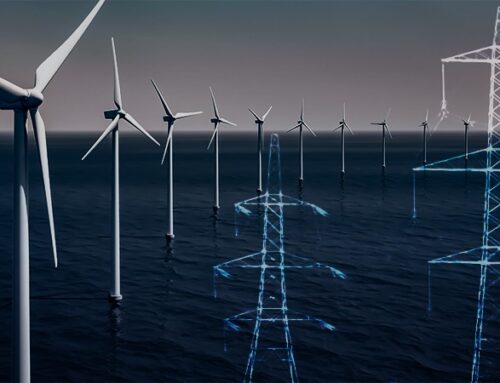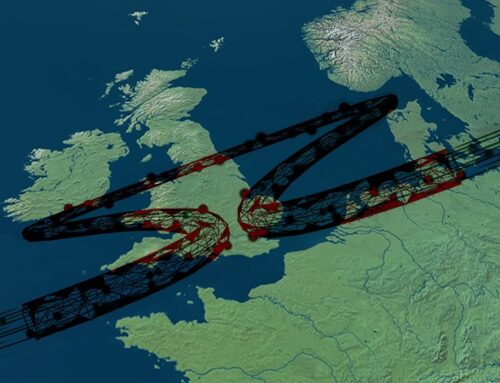One of the consequences of the energy transition and the increase in renewable generation on the electricity system has been the growth in negative electricity prices, where production is curtailed and/or consumers are paid to take surplus generation. These events are still relatively rare in Britain, but in Germany, where renewables penetration is around a third of total electricity generation, negative pricing is much more common.

2019 saw the first major instances of negative pricing in the GB market with imbalance prices turning negative in March, and again in May, and even the day-ahead price fell below zero in December on the back of high wind generation during Storm Atiyah.
“Unprecedented” events see imbalance prices turn negative in March
Sunday 24 March saw the GB system price fall to -£50 /MWh from settlement period 21 (10:00 – 10:30) and remain negative for 13 consecutive settlement periods until 16:30 as unseasonably warm and bright conditions led to lower demand than would normally be expected. According to Limejump’s trading team, the price fell as low as -£70.24 /MWh during settlement periods 28 and 29, due to the “shock effect of the sudden sunny weather”, resulting in what the energy trader described as an “unprecedented turn of events”.

Electricity demand at was 30.7 GW at 10:00 and 31.2 GW at 11:00, significantly below the 34 GW of demand on the previous Sunday. At the same time, renewable generation was higher than expected with solar output rising to double its usual levels for the time of year, with the sunny weather. Solar generation peaked at 7.7 GW, more than double the seasonal average of 3.5 GW, and considerably higher than the 6.5 GW forecast for the day. Wind output was also strong.
Analysis by Cornwall Insight indicates that National Grid was forced to turn down windfarms alongside some biomass and gas-plant to balance the system, however at the same time, other CCGTs were required to increase their output, suggesting that it was the need to manage transmission constraints in Scotland rather than the simple generation surplus that drove the necessary balancing actions.
May saw an even longer period of negative electricity prices
In late May, again on a Sunday, the GB system saw imbalance prices turn negative yet again, this time for an even longer period – nine consecutive hours. Unusually low demand, around 2 GW below forecasts, combined with high wind generation forced National Grid to instruct both onshore and offshore wind farms to turn down.
Prices fell as low as -£71.26 /MWh on Sunday 26 May, and after recovering briefly, they fell below zero again between 23:34 on the 26th and 01:45 on the 27th. The average system price on 26 May was -£12.16 /MWh.

National Grid’s daily balancing costs report for 26 May 2019 indicates that the total balancing costs for the day were over £7.7 million, compared with £1.5 million the day before. In its report, National Grid stated that system inertia and voltage support were the main concerns for the day
More negative prices in December with day-ahead prices also falling below zero
Stormy weather in early December saw high wind output that triggered negative prices for a record length of time, according to National Grid. On 7 December wind power accounted for just over 40% of generation at 19:47, and by midnight had risen to just under 48% as output reached 13.95 GW. Wind generation continued to be strong throughout the following day, as Storm Atiyah moved across the country, hitting a new record of 16.162 GW (and went on to exceed 17 GW a few days later).
This surge in wind generation saw power prices turn negative from around 10:45pm on 7 December until 12:45pm on the 8th, meaning consumers were paid to offtake power.

“This weekend was a short glimpse of how a smart, flexible system, when fully developed, will be able to respond to high periods of renewable generation, balance the system, and store that electricity for later use. An excellent example of how quickly we have adapted to the changing generation mix and a window into the future of system operation,”
– Madeline Greenhalgh, policy and advocacy manager at Regen

Twitter lit up with hundreds of tweets celebrating the high levels of renewable generation and hailing a “net-zero” future of a flexible, green energy system, however it seems to have escaped the notice of most commentators that even during this period of record wind output, the GB market was still running coal at 2-5% of total generation.
On 9 December, the UK experienced a negative day-ahead electricity price for the first time, with prices for 03:00 to 04:00 delivery on the hourly day-ahead auction dropping to -£2.84/MWh. On the same day, negative pricing was also observed throughout German, Dutch and Belgian day-ahead power prices, with German prices dipping to -€16.09/MWh between 02:00 to 03:00 (GMT).
During this period of negative prices, GB was receiving 1.1 GW through the NEMO and BritNed interconnectors and was exporting 1.4 GW through the IFA to France – the GB market was effectively increasing the cross-border capacity into France from its continental neighbours (although this is not an unusual way for the interconnectors to operate).

This is interesting – received wisdom has long held that higher levels of interconnection will help to smooth European prices, moving power from regions of surplus to regions of deficit, but as I have noted before where northern European countries experience similar weather, the interconnectors may not behave this way. In fact, as the GB market becomes more connected with Europe, it may well see more instances of negative pricing as electricity surpluses across Northern Europe try to find a market, and could act as a transit country on more occasions.
Short-term prices set to become more volatile…
As the amount of zero marginal cost renewable generation on the system increases, the frequency and duration of negative spot pricing will increase. While many see this as a positive development and talk up the benefits of flexible consumption in managing these generation surpluses, the lack of large-scale, long duration electricity storage means that short-term price volatility will grow. This was perfectly illustrated on 9 December, when, as the storm abated and wind output fell, electricity prices spiked above £100 /MWh between 16.30-18.00 as CCGTs came on to compensate for falling wind generation.
Analysis by Cornwall Insight sees the number of times prices fall below zero and spike above £120 /MWh both rising. By 2034, 14% of half-hourly settlement periods could outturn at negative prices, although the analysis sees price spikes levelling off at around 10% of settlement periods.

These price swings could be beneficial for investors in flexible generation and storage, but a general reduction in wholesale prices and a narrowing window of opportunity to sell into markets already well supplied with renewable generation would make it increasingly hard to achieve a return on unsubsidised wind and solar projects.
Cornwall Insight estimated a 10 MW onshore wind project built in the UK in 2031 would make 34% less revenue than one built today, while a 5 MW solar project would see revenues cut by 22%.
“Our analysis presents a wholesale market with increasing price volatility as the sources of dominant supply switch between ‘must run’ subsidised generation and flexible, short-run marginal price-based generation. This creates a [high risk] environment with significant implications not just for generators, but for all parties including off-takers, suppliers, end-users and the system operator. With so much activity being focussed to the periods close to delivery the forward market cannot provide sufficient hedge for those that require price certainty and stability,”
– Tom Musker, senior modeller, Cornwall Insight
….. and may drive system costs higher
The inability of flexible consumption to act over longer periods means this excess power needs to be consumed more or less as generated. More periods of low or negative pricing will mean non-renewable generation will require higher prices in times of low renewable output, which may send capacity market pricing higher.
In addition, balancing actions by the system operator for example calling on turn-up demand-side response contracts or asking generators to curtail production, incur costs that are ultimately borne by consumers. National Grid’s daily balancing reports for the days in which negative prices were observed show much higher than normal balancing costs (24 March, 26 May and 7 December)
In the GB market, Contracts for Difference (“CfDs”) are used to protect renewable generators from wholesale market price volatility by providing a guaranteed price relative to the day-ahead market price. Payments are only available if the generator has sold its output into the day-ahead market, creating a strong incentive for them to do so.
If subsequently, the generator produces more than it sold, for example a windfarm might generate more than expected if the weather is windier than forecast, the generator will be subject to imbalance costs. In the case of negative imbalance prices, there is no dis-incentive to over-produce, and if the system operator asks the generator to reduce output, it will receive a curtailment payment.
This creates a significant market distortion: the increase in zero-marginal cost sources of production will depress wholesale power prices, lowering returns for non-renewable generators and renewable generation that has been built either without a subsidy, or with one of the other subsidy schemes. The higher frequency of price spikes is unlikely to compensate for this, particularly as generators may not always be able to capture the benefits of these depending on their selling patterns.
Of course, one solution to this would be to adopt the idea floated by Dieter Helm in his energy market review – to make the creators of intermittency pay its costs. This would go some way to addressing a distortion that will have an increasing impact on the market as the frequency of negative price periods increases.
.
The amount of renewable generation on the system is set to grow, driven by political ambitions for a net-zero economy, but some hard thinking needs to be done on how the economics of electricity generation are going to change as a result. The current hotch-potch of subsidies is unfit for purpose even in today’s market – a new approach needs to be devised in order to ensure the necessary investments are made to deliver a secure energy system in the future.






You had me scurrying back to the CFD Standard Terms and Conditions and finding a hot towel to wrap around my head to get through the legalese.
https://assets.publishing.service.gov.uk/government/uploads/system/uploads/attachment_data/file/599098/FINAL_CFD_Standard_Terms_and_Conditions_V2-_13_March_2017_.pdf
Start on p 96 Part 5B. We see that for intermittent generators day ahead hourly prices (after a lot of cross referencing) are basically the average trade on APX, which BM Reports now shows here: https://www.bmreports.com/bmrs/?q=balancing/marketindex (the market isn’t apparently trading N2EX. Also note the report includes traded volumes which can be compared against generation data to see what proportion is traded in this way). There are some very complicated provisions to do with taking account of over the counter markets reported by services like ICIS-Heren, and what happens if there is no trade for a given period (fallback first to the price a week beforehand, etc.). Next, we have to scurry back to page 15 to find the definition of “Difference” = MIN (SPt -MRPt ,SPt) – that is, the current CFD strike price less market reference price, or just the strike price if the market reference price is negative. Fast forward again to p 97 to see
Intermittent Difference Amount = Difference x MAX(MIN(Qt x ht x TLMt ,Mt),0)
where:
Qt is the Maximum Contract Capacity applicable to Settlement Unit (t);
ht is the number of hours in Settlement Unit (t);
TLMt is the transmission loss multiplier allocated in accordance with the BSC,
or any new or substituted multiplier or factor which is in the nature of, or
similar to, a transmission loss multiplier, in Settlement Unit (t); and
Mt is the Metered Output during Settlement Unit (t),
provided that in respect of any and all Settlement Units which form part of an
Intermittent Rolling Negative Price Period, the Intermittent Difference Amount shall be
zero (0);
“Intermittent Rolling Negative Price Period” means a period of six (6) or more
consecutive Settlement Units (irrespective of whether or not such Settlement Units fall
within the same Billing Period) in respect of which the Intermittent Market Reference
Price is negative (that is, less than £0/MWh);
So we have that the payment offers no compensation for the negative element of reference prices, being capped at the strike price, and the quantity is capped at the lower of the declared capacity adjusted for transmission loss, or the metered volume, and there is no adjustment if the meters show net consumption (i.e. very low wind with power used for yaw motors, turning the shafts to prevent brinelling and warping, and de-icing etc.) The big gotcha is that they get no CFD compensation at all if prices stay negative for six continuous hours or more for any of the period of negative prices: they just get whatever they sold their power for.
Note that there is nothing that requires the CFD holder to have sold on the day ahead markets explicitly – as far as I can see they remain free to make forward hedge sales, and spot sales any time up to gate closure and otherwise trade the market by buying and selling, just as for any normal generator. There is no incentive for them to chase APX prices into negative territory, as that reduces their net proceeds, but they do have the insulation of the entire strike price down to zero market price, which allows them to price in a predatory manner, but ultimately they would curtail voluntarily at the negative value of their strike price less marginal costs, and they have an incentive to curtail once there is a six hour period of negative prices (it is more profitable to buy back at a negative price prior to gate closure any energy they have already sold previously and produce nothing, but they may gamble on securing curtailment payments inside gate closure being more profitable). I assume that BSuOS balancing charges only apply to imbalance volumes after gate closure, as adjusted for any curtailment.
The position for those who get ROs is different. They simply get their RO entitlements regardless of market price, plus whatever they sell their output for. That means that they can achieve positive marginal revenue at prices down to the value of their RO entitlement less marginal costs. Below that, they have an incentive to curtail voluntarily if they can’t con curtailment payments out of the system.
Normal generators get only whatever they sell their output for. It’s hard to see how this provides suitable compensation for CCGT providers of inertia, when they could choose to shut down and cash in on negative prices to buy back what they had sold far more profitably. They are going to need to be compensated for doing so – otherwise we will be in blackout territory again.
It does seem somewhat confusing and one would hope that the regulator would be able to tell customers what these rules really mean.
For example a table describing the situation might help.
Indicating how power a producer was committed to providing and over a period, and the costs (paid by them) of not providing sufficient power, the cost to the consumers of that power and of not using all the committed power.
That would give the consumers some idea of the true cost of these deals.
Of course the period could be a year or a month or even part of a day; the use of historical data would enable people to see how high the cost of non-supply was (eg starting up a gas power station etc…)
OFGEM have, recently suggested that they want more electric cars and wind turbines to supply them; this makes this discussion much more pertinent – asI am worried that OFGEM seem not to be overly concerned with loss of power issues (and consumer costs)
These are some great idea about the negative electricity prices that you have discussed here. I really loved it and thank you very much for sharing this with us. You have a great visualization and you have really presented this content in a really good manner.